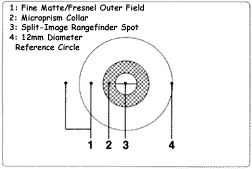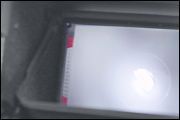Unlike professional class Nikon F-bodies which each generation of the F models has a dozen or two dedicated focusing screens to choose from for handling many varying applications and matching lens types used. The FM/FE class mid compact Nikon SLR bodies have only three basic focusing aid to choose from. Each of these screens, although less in number as compared, but if you know how to make good use of them creatively, they may supplement your works very handily.
 |
The typical design of the finder in FM3a has been used since the '60 and since then, it has been made a standard on virtually all manual focus Nikon SLRs. It serves both as a focusing aid as well as metering reference. The standard screen that comes along with the FM3a has a very sexy name 'Spliprism-image Rangefinder Microprism'. Its basic layout is almost similar to previous screen K, K2 type, except the center split image rangefinder has a marginally smaller diameter. The standard screen comprises of a microprism collar around the central splitprism-image rangefinder spot, microprism collar and a matte outer field. |
Other than the standard screen type, Nikon has designed two other separate screens specifically for the FM3a. The two types of screen are available for optional replacement: B3 type (Clear Matte IIa) and E3 type (Etched screen with horizontal and vertical lines). The two are similar in design to E/E2 and E/E3 to aid photographers that need such requirement except they are brighter now.
 |
 |
 |
All the 3 screen types have a 12mm circle at the center which serve no other purpose other than indicating where the proportion of the 60% heavy center-weighted average metering is concentrating. |
 |
The standard screen is a multi-purpose one-for-all and all-for-one screen type which is a good screen for general photography. The plain B3 screen has only the 12mm reference circle to outline the concentrated metering area of 60% and it is always been my preferred screen type as nowadays I used camera mostly for macro works. The grid screen is often being regarded as a good screen for copy work or architectural photography; but it is also very useful for registering repetitive image such as multiple exposures. |
Select the right screen is a matter of personal preference. Actually, to determine focus by looking at the image on a matte screen depends a lot on your eyesight. Split Image of the standard screen comprises of two small prisms with their faces angled in opposite directions and it is often called a bi-prism. However, alignment of lines or edges which are often found in normal pictorial scenes make split-image a good way to find focus but if the image consists mainly of horizontal lines, it will be difficult to see any indication of focus. That is why sometimes I thought Nikon should also consider an additional screen type with split-image angled at 45 degrees to give some focus indication on both vertical and horizontal lines.
One slight drawback of split-image screen is the tendency for the bi-prism to blackout during certain lighing condition. Most often this phenomenon happens with long focal length lenses of small maximum aperture. It can also happen when stopping down the lens to view depth of field or performing stop-down metering. Technically, a smaller prism in the split image may reduce such possibility and nowadays zoom lenses with variable small aperture are very popular and probably this is one reason why the split-image of the new screen type has a smaller diameter.
 |
The external circle surrounding the split-image rangefinder spot is the microprism which comprises an array of many small pyramids just outside the split-image rangefinder spot is more useful on scenes without strong geometric lines. It displaces small segments of the image causing it to split and it has a fuzzy appearance and when focus is achieved, the seems to snap into focus. If you have problem making use of the split-image to focus, the microprism compensates for that. |
 |
Since the pentaprism is a fixed type and you may not be able to view the interior. Actually there is another fixed optical condenser glass placed mid between the focusing screen and the pentagonal prism which has the exposure menu imprint onto it. Shown here was when the focusing screen has been removed to reveal how it looks above the focusing screen. |
In relation to interchangeability of focusing screen with older FM2n/FE/FA. Nikon indicated inside the instruction manual that when you use a new K3, B3, or E3 screen type specially designed for FM3A camera with an Nikon FA, FE2 or Nikon FM2(n) camera, NO exposure compensation is required. Although it makes no sense to do so, but some owners of previous model may already owned, for an instance, a E2 grid screen and may not often use it and thus does not justify to acquire another screen type with similar function, in such case, I am not able to help as I am not sure how much compensation should adjust when you used an older screen type onto the FM3a. Probably some of you out there can help to address this issue for me via the | Message Board |.
 |
 |
 |
How to distinguish the applicable types. |
| K3 type, B3 type, E3 type | K2 type, B2 type,
E2 type (for New FM2, FA and FE2) |
Type K/B/E have only a straight tab. |
In relation
to Focusing Screen Installation, maintenance and other related information,
you may |
Click
Here
| to a
separate section and refer.
Previous | NEXT | A Personal Conclusion
Page 1 | 2 | 3 | 4 | 5 | 6 | 7 | 8 | 9 | 10 | 11 | 12 |
| BACK | to Main Index Page
of Nikon FM3A
|
Other
Issues
relate to Nikon FM3A - Index
Page
|
| Instruction Manual for Nikon FM3A
|
| Technical Specification |
Main
Reference Map
|
Standard
production Nikon FM Series models:-
Nikon FM | Nikon FM2 | Nikon FM2n | Nikon FM10 | Nikon FM3a |
Known
variants:-
Nikon
FM Gold
| Nikon
FM2/T
| Nikon
FM2N Tropical Set
| Nikon
FM2/T Limited Edition
| Nikon
FM2N LAPITA
|
Nion
FM2n Millennium 2000
| Message Board | for
your favourite Nikon
FM Series SLR models
| Message
Board | for your Nikon
Optics in a shared environment
| Message Board | Specifically for Dispose or Looking for Nikon/Nikkor
Photographic Equipment
| Back | Main Index
Page of Nikon FM series Bodies
Shared Resources: MD-11 | MD-12 | Focusing Screens | Titanium Shutter | older dedicated Flash Units for FM series -SB-16 | SB-15 | SB-10 or other Options | Databack | Nikkor lens mount (related info)
Others:- Nikon AF-TTL Speedlights | SB-20 (1986) | SB-22 (1987) | SB-23 | SB-24 (1988) | SB-25 (1991/2) | SB-26 (1994) | SB-27(1997) | SB-28 (1997) | Nikon SB-29(s) (2000) | Nikon SB-30 (2003) | Nikon SB-600 (2004) | Nikon SB-800 (2003) Nikon AF-TTL Speedlight DX-Series: Nikon SB-28DX (1999) | SB-50DX (2001) | SB-80DX (2002) (updated)
Nikon
BC-flash Series |
Original
Nikon Speedlight
SB-2
| SB-3
| SB-4
| SB-5
| SB-6
| SB-7E
| SB-8E
| SB-9
| SB-E
| SB-10
SB-11
| SB-12 | SB-14 | SB-140 UV-IR| SB-15 | SB16A | SB-17 | SB-18, SB-19 | SB-21A (SB-29) Macro flash | Flash Accesories | SF-1
Pilot Lamp
Instruction
Manual: Nikon FM (HTML | PDF) | Nikon FM-10 (HTML) | Nikon FM2n's
User's Manual
available only in HTML format (6
parts) | Nikon FM3A (HTML)
Specifications: Nikon FM, FM-10, FM2, FM2n and FM3A
Main Reference Map: (HTML) Nikon FM, FM2, FM-10, FM2n (Applicable
to FM2T, FM2 "Year of the Dog"; Millennium 2000") and FM3A
| Nikon F | Nikon F2 | Nikon F3 | Nikon F4 | Nikon F5 | Nikon F6 | Nikkormat / Nikomat | Nikon FM | Nikon FE/ FA | Nikon EM/FG/FG20 | Nikon Digital SLRs | Nikon - Other models |
Nikon Auto Focus Nikkor lenses:- Main
Index Page
Nikon Manual Focus Nikkor lenses:- Fisheye-Nikkor Lenses - Circular | Full Frame |
Ultrawides Lenses - 13mm15mm18mm20mm | Wideangle Lenses - 24mm28mm35mm | Standard Lenses - 45mm 50mm 58mm | Telephoto
Lenses - 85mm105mm135mm180mm & 200mm | Super-Telephoto Lenses - 300mm 400mm 500mm 600mm 800mm 1200mm |
 Index Page |
Special
Application lenses: Micro-Nikkor Lenses - 50mm~55mm -60mm 85mm -105mm 200mm Micro-Zoom 70-180mm Perspective Control (PC) - 28mm 35mm PC-Micro 85mm Dedicated Lenses for Nikon F3AF: AF 80mm f/2.8 | AF 200mm f/3.5 EDIF Depth of Field Control (DC): 105mm 135mm Medical Nikkor: 120mm 200mm Reflex-Nikkor Lenses - 500mm 1000mm 2000mm Others: Noct Nikkor | OP-Nikkor | UV Nikkor 55mm 105mm | Focusing Units | Bellows-Nikkor 105mm 135mm Nikon Series E Lenses: 28mm35mm50mm100mm135mm | E-Series Zoom lenses: 36~72mm75~150mm70~210mm |
MF Zoom-Nikkor Lenses: 25~50mm | 28~45mm | 28~50mm | 28~85mm | 35~70mm | 36~72mm E | 35~85mm | 35~105mm | 35~135mm | 35~200mm | 43~86mm | 50~135mm | 50~300mm | 70~210mm E | 75~150mm E | 80~200mm | 85~250mm | 100~300mm | 180~600mm | 200~400mm | 200~600mm | 360~1200mm | 1200~1700mm
Tele-Converters: TC-1 | TC-2 | TC-200 | TC-201 | TC-300 | TC-301 | TC-14 | TC-14A | TC-14B | TC-14C | TC-14E | TC-16 | TC-16A | TC-20E
Recommended links to understand more technical details
related to the Nikkor F-mount and production Serial Number:
http://rick_oleson.tripod.com/index-153.html by: my
friend, Rick Oleson
http://www.zi.ku.dk/personal/lhhansen/photo/fmount.htm by: Hansen,
Lars Holst
http://www.mir.com.my/rb/photography/hardwares/nikonfmount/lens2.htm
http://www.photosynthesis.co.nz/nikon/serialno.html
W A R N I N G: The New G-SERIES Nikkor lenses have no aperture ring on the lens, they CANNOT ADJUST APERTURES with any of these manual focus Nikon FE series SLR camera models; please ignore some portion of the content contained herein this site where it relates.
|
Back | Main Index Page of Nikkor Resources
|
Back | Main Index Page of Pictorial
History of Nikon SLRs
| Message Board | for your Nikkor optics ("shared" because I do wish some of you to expose to other's perspective as well. Isn't it a sad sate to see photography has to be segmented into different camps from the use of various labels)
about this photographic web site
Home - Photography in Malaysia |
Credit: To all the good people who has contributed their own experience, resources or those who are kind enough granting us permission to use their images appeared in this site. Mr. MCLau®, who has helped to rewrite some of the content appeared this site. Chuck Hester® who has been helping me all along with the development of all these Nikon websites;LarsHolst Hansen, 'Hawkeye' who shares the same passion I have; Ms Rissa, Sales manager from Nikon Corporation Malaysia for granting permission to use some of the official content; TedWengelaar,Holland who has helped to provide many useful input relating to older Nikkor lenses; Some of the references on production serial numbers used in this site were extracted from Roland Vink's website; HiuraShinsaku from Nikomat Club Japan. t is also a site to remember a long lost friend on the Net. Note:certain content and images appeared in this site were either scanned from official marketing leaflets, brochures, sales manuals or publications published by Nikon over the years and/or contribution from surfers who claimed originality of their work for educational purposes. The creator of the site will not be responsible for may discrepancies arise from such dispute except rectifying them after verification."Nikon", "Nikkormat", "Nippon Kokagu KK" & "Nikkor" are registered tradename of Nikon Corporation Inc., Japan. Site made with an Apple IMac.